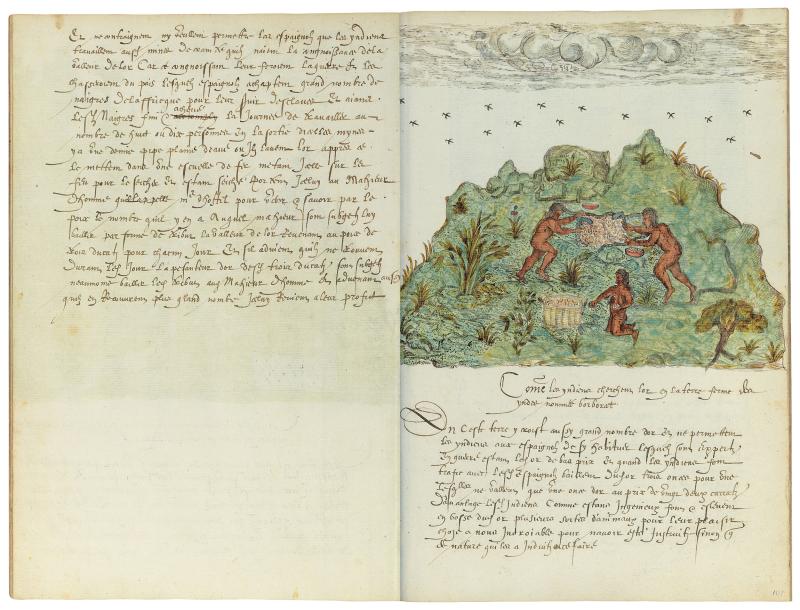
Histoire Naturelle des Indes
Illustrated manuscript
Bequest of Clara S. Peck, 1983
Continued from fol. 100
The Spaniards do not force nor permit the Indians to work in the mines for fear they should know the value of the gold for, knowing it, they would go to war and chase them out of the country. The Spaniards buy a great number of negroes from Africa to serve them as slaves and when the negroes have finished a day's work in a group of eight or ten, there is at the exit of these mines half a barrel filled with water in which they wash the gold. Then they put it in an iron bowl and place it on the fire to dry it. When it is dry, they take it to the Major-domo, whom they call "Maître d'hôtel," in order to see and know from the weight how much it is. They have to give him, as tribute, the value of the gold amounting to the weight of three ducats for each day. If it happens that they do not find in one day the weight in gold of three ducats, they are liable nevertheless to pay the tribute to the Major-domo. If it happens also that they recover a larger amount, it will be their gain.
Come Les Yndiens Cherchent Lor En La Terre Ferme Des Yndes Nommée Borborat (How the Indians Look for Gold on the Mainland of the Indies Called Borborat)
There is in this region also a great deal of gold. The Indians do not allow the Spaniards who are experts in war to settle there, the gold being of low value. When the Indians trade with the Spaniards, they give three ounces of gold for one as they [the three ounces] are only worth one ounce of gold at the price of twenty-two carats. Besides, the Indians, ingenious as they are, make and fashion in gold relief several kinds of animals for their enjoyment which is something unbelievable to us since they are taught only by nature which induces them to do this.
In 1983, The Morgan Library & Museum received, as the bequest of Clara S. Peck, an extraordinary volume whose beautiful paintings and descriptions document the plant, animal, and human life of the Caribbean late in the sixteenth century. Spaniards had already begun to exert influence over the indigenous people of the area when explorers from England and France arrived, among them Sir Francis Drake. The volume, known as the Drake Manuscript and titled Histoire Naturelle des Indes when it was bound in the eighteenth century, gives us a wonderful picture of daily life at the time of Drake's many visits to the region. Although Drake's connection to the manuscript is uncertain, he is mentioned on more than one occasion by the authors. Drake himself is known to have painted, but none of his work survives.
Contents: 199 images of West Indian plants, animals and human life, with accompanying manuscript captions written in late sixteenth-century French.
Medium: Most of the illustrations consist of a black chalk underdrawing and a combination of pen and brown ink with watercolor; on some images selected areas have also been glazed with a gum.
Binding: Bound or rebound in brown leather in the late 18th century.
Pagination: Penciled folio numbers (1–125) in lower right corner of each page were added by The Morgan Library & Museum. Folios 92v–93, 93v–94, and 95v–96 are fold-out leaves.
